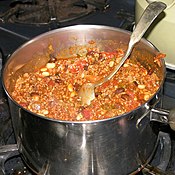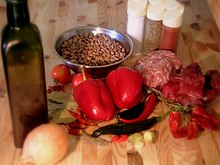Cookbook:Chili con Carne
Cookbook | Recipes | Ingredients | Equipment | Techniques | Cookbook Disambiguation Pages | Cuisine of the United States

Chili con carne (sometimes simply shortened to chili) is a spicy stew-like dish, generally containing chile peppers. There is dispute over the components of chili, with arguments that 'true' chili does not contain beans/tomatoes/meat/etc. However, chili as it is commonly known in the USA typically features tomatoes, beans, and meat, along with other vegetables. There are many variations according to geography and personal preference. There are also vegetarian versions, sometimes known as chili sin carne, which are made without meat. The name "chili con carne" is a slight corruption of the Spanish chile con carne, meaning "chiles with meat". Chili con carne is the official dish of the U.S. state of Texas.
Components
[edit | edit source]
Beans
[edit | edit source]Pinto beans (frijoles), a staple of Tex-Mex cooking, have long been associated with chili, and the question of whether beans "belong" in chili has been a matter of contention among chili cooks for an equally long time. It is likely that in many poorer areas of San Antonio and other places associated with the origins of chili, beans were used rather than or in addition to meat, due to poverty. In that regard, it has been suggested by some chili aficionados that there were probably two chili types, depending on what could be afforded and how frugal the cook was.
As chili spread east into areas where beef was more expensive (beef was plentiful and cheap in San Antonio and other cattle towns), chili with pinto or other beans became more prevalent. In some eastern areas, this dish is referred to as "chili beans" while the term "chili" is reserved for the all-meat dish. Other changes included the adding of other vegetables. Bell peppers are common, and even celery appears in recipes. Many easterners are just as adamant about the inclusion of beans in their chili for an authentic flavor as Texans are about their exclusion.
Most commercially-prepared canned chili includes beans. Commercial chili prepared without beans is usually called "chili no beans". If you substitute chunks of fresh mushrooms for the beans, you will cut the calorie content of your favorite chili recipe by at least a third, without sacrificing taste. The bland white button mushroom will soak up the flavors of the chilies, tomatoes, chili powder, etc, while helping the chili retain its consistency.
Many chili experts believe, however, that beans and chili should always be cooked separately and served on the side. It is then up to the consumer to stir his preferred quantity of beans into his own bowl. Some cooks prefer black beans, black-eyed peas, or kidney beans instead of pinto beans.
A popular saying among chili purists is "If you know beans about chili, you know chili ain't got no beans".
Tomatoes
[edit | edit source]Another ingredient considered anywhere from required to sacrilegious is tomatoes. Wick Fowler, north Texas newspaperman and inventor of "Two-Alarm Chili", insisted on adding tomato sauce to his chili. He also believed that chili should never be eaten newly-cooked but refrigerated overnight to seal in the flavor.
Varieties
[edit | edit source]Texas chili
[edit | edit source]Texas chilis are generally beef-based, use dried red chili peppers, and are therefore red in color. They contain no beans and little or no vegetables other than the chili peppers.

- Original Texas-Style Chili: This recipe contains no vegetables except chilies which have been prepared by being boiled, peeled, and chopped.
- Jailhouse Chili: In the early part of the 20th century, those likely to regularly spend time in local detention facilities in the American Southwest were said to rate the accommodations by the quality of the chili they were served. This became a matter of local pride and competition with other communities. This is a modern version, as served in the Texas prison system.
- Pedernales River Chili: This chili was the favorite of U.S. President Lyndon Johnson and is named after the location of his Texas Hill Country ranch. Johnson preferred his chili made with venison. [1]
- Texas Easy Chili: This recipe is a chili powder- and tomato juice-based sauce combined with cubed or ground beef.
New Mexico chili
[edit | edit source]The official state vegetable of New Mexico is the chili pepper and the official state question is "Red or green?" This refers to the decision New Mexican chili devotees must regularly make, and which engenders frequent discussion and argument. The red chili is simply a riper form of the green chili; the former is cooked in its dried form and the latter is used fresh from the field, with significant differences in results. For those who simply cannot decide, the standard reply is "Christmas", meaning a portion of each. New Mexico chilies are more commonly based on pork, and include more vegetables than Texas style chilies.
- New Mexico Chile Verde: Chile verde ("green chili") is generally considered more typical of New Mexican cuisine, possibly because of its more marked visual contrast to Texas-style chili. While there apparently is no canonical recipe for chili verde, all versions involve roasting fresh green chilies and cooking them slowly with meat, garlic, oregano, and cumin.
- Green Chili Stew: This recipe is a New Mexican dish that is known as the beef stew of New Mexico. It is usually served with tortillas or sopapillas.
- Chile Colorado: Chili Colorado ("red chili") is a pork-based chili from New Mexico that uses dried red chili peppers.
Other meat-based chilis
[edit | edit source]- Chili con Bambi: Another venison based chili con carne. Intended for slow cooking so can use very tough meat.
- Cincinnati-Style Chili: Cincinnati-style chili is a very popular regional variation that is quite different from Texas-style chili. Most notably, it is usually eaten as a topping for spaghetti or hot dogs, rather than as a stew by itself. Cincinnati-style chili is beanless, but a "four-way" serving includes beans on top of the spaghetti under the chili. The connection between cheddar cheese and chili probably originated in Cincinnati, since the cheese normally tops Cincinnati spaghetti dishes.
- White Chili: Instead of a tomato-based sauce and red meat (beef), great northern beans and chicken breast meat can be substituted. The resulting dish appears white when cooked, and has more of an alkali bean taste, instead of the acidic taste of traditional chili.
- Pepper chili: Chili made with bell-peppers
Vegetarian chili
[edit | edit source]Vegetarian chilis acquired wide popularity in the U.S. during the 1960s and 1970s with the rise of the vegetarian philosophy, and is also popular with those on diets which restrict red meat. To make a chili vegetarian, the meat is left out of the recipe or replaced with a meat analogue such as textured vegetable protein or tofu. Some people consider vegetarian chili to be a spicy vegetable stew, and not true chili.
- Vegan Chili: This is a kind of chili that needs no meat (and uses no ersatz meat). Molasses gives this chili a somewhat Louisiana flavor.
- Bean Chili: This chili recipe, which is also vegan, uses kidney beans, red and green bell peppers, and chili powder.
- Black Bean Chili: This vegetarian chili uses black beans.
Serving
[edit | edit source]Several beverages are commonly used to accompany a bowl of chili, including ice-cold beer or cold milk to moderate the impact of the chilies on the throat. Saltine crackers, broken up and scattered on top, are common in chili parlors. Similarly, commercial corn chips can be added as a topping, producing something akin to Frito Pie. Jalapeño cornbread, rolled-up corn tortillas, and pork tamales also are popular for dunking. Peanut butter sandwiches or peanut butter on saltine crackers served on the side can also accompany chili. In Missouri, a small portion of pickle juice is often poured into the bowl of chili. In Indiana, some heap coleslaw in their bowl of chili before eating. In Southeast Texas people eat chili over white rice, much like one would eat gumbo; this is due to the proximity to Louisiana; this is also common in the United Kingdom.
Similar dishes
[edit | edit source]Dishes often described as similar to chili con carne include French cassoulet, Indian curry, Jewish cholent, Serbian bean soups and especially Hungarian goulash.
Recipes
[edit | edit source]For a complete list of chili recipes, see Category:Chili recipes or browse below:
References
[edit | edit source]- This module uses content from the Wikipedia article "Chile con carne", and is used under the terms of the GNU Free Documentation License.
- Frank X. Tolbert. A Bowl of Red: A Natural History of Chili con Carne. Garden City, N.Y.: Doubleday, 1966. [Much of the material in this book originally appeared in the author's newspaper columns in The Dallas Morning News beginning in the early 1950s.]
- Charles Ramsdell. San Antonio: An Historical and Pictorial Guide. Austin: University of Texas Press, 1959.
- Joe E. Cooper. With or Without Beans. Dallas: W. S. Henson, 1967.
- H. Allen Smith. "Nobody Knows More About Chili Than I Do." Reprinted at the International Chili Society web site.
- Jack Arnold. The Chili Lover's Handbook. Privately published, 1977.
- Robb Walsh. The Tex-Mex Cookbook: A History in Recipes and Photos. New York: Broadway Books, 2004. [A very knowledgeable and very well-written "food history", including a long chapter on "real" chili, chili joints, and the San Antonio chili queens.]